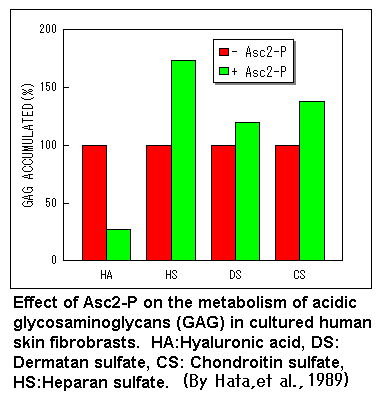| Collagen Synthesis of APM |
| "Existence of manufunctioning Pro a2 (1) collagen genes in a patient with a
pro a2 (1) -chain-defective variant of ehlers-danlos syndrome" R.Hata, et al.,
Eur.J.Biochem,vol. 174, p231, 1988. |
| "L-ascorbic acid 2-Phosphate stimulates collagen accumulation,cell
proliferation, and formation of a Three-Dimensional tissuelike substance by skin
fibroblasts." R.Hata, et al., J.Cell.Physiol, vol.138, p8-16, 1989. |
| "Co-Culture of fibroblasts and Hepatic Pareachymal Cells induces metabolic
changes and fomation of a three-dimensional structure" H.Senoo, et al.,
Cell.Biol.Int.Reports, vol.13, p197, 1989. |
| "Ascorbic acid phosphate stimulates Type 4 collagen synthesis and
acceieretes adipose conversion of 3T3-L1 cells" M.Ono, Experimental Cell
Research,187,p309-314, 1990. |
| "Epidermal growth factor inhibits trnscription of type 1 collagen genes and
production of type 1 collagen in cultured human skin fibroblasts in the presence
and absence of L-ascorbyl-2-Phosphate, a long-acting Vitamin C derivative."
S.Kurata, et al., J.Biol.Chem., vol.266, p.9997-10003
(1991) |
In general cell cultures even normal cells do not grow, accumulating as tissue as fffin vivofff. Hata et al. found that cultured cells formed three-dimensional tissue fffin vitrofff when APM was added to the culture. It was found in the study of type I collagen mRNA of skin fibroblasts incubated in APM containing cultures that APM not merely promotes the hydroxylation of proline, one of the collagen protein amino acids, but also activates gene expression of collagen itself.
In addition, AMP is also said to promote cell accumulation by proteoglycan sulfate, one of the combinations of proteins called proteoglycans, one of the extracellular matrix constituents other than collagen, and mucopolysaccharides. Information has been gradually accumulated that unveils diverse hidden actions of vitamin C.
Glycosaminogriycans metabolism

|

 @@@@@
@@@@@